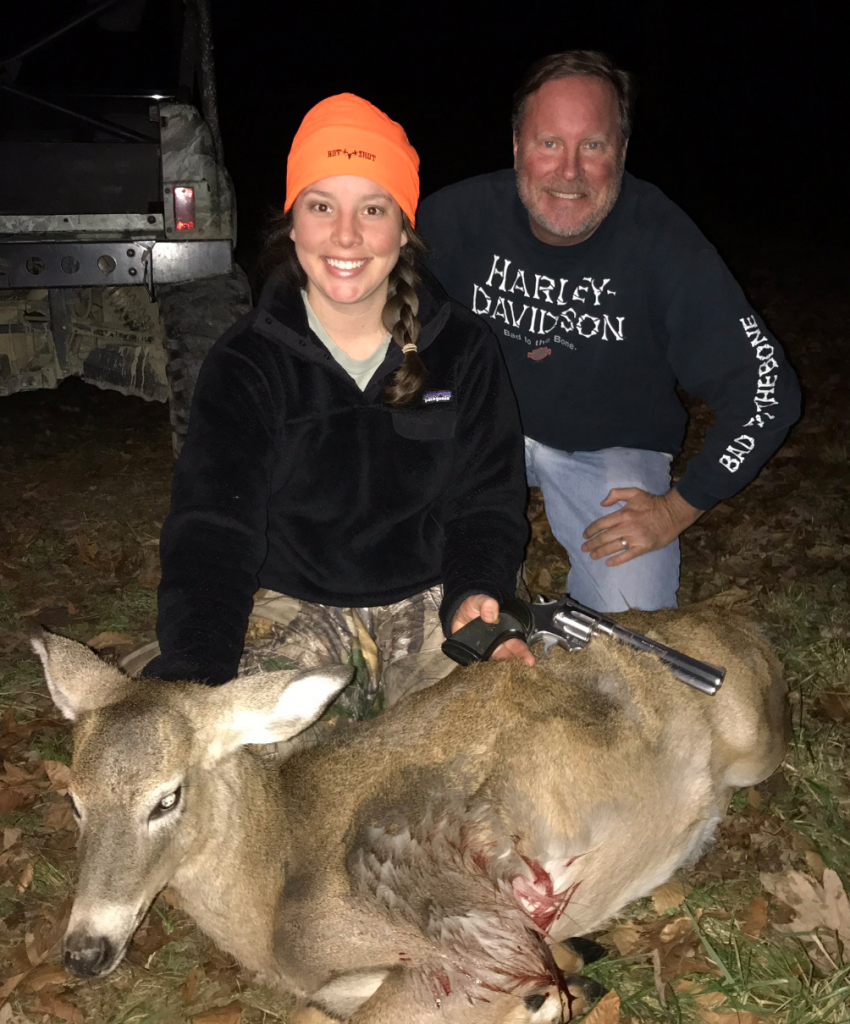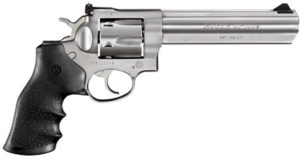
If you’re interested in handgunning for whitetail deer one question may arise that will stir debate: Is the .357 Mag a strong enough caliber?
With hunting, animals run wild and rumors run wilder.
One of these rumors is if you hunt with a handgun you need an extremely powerful caliber to kill deer. Consequently, many handgun hunters — and hunters who might think about handgun hunting — have succumbed to the myth that unless you have at least a .44 Mag., you have no business hunting deer.
You see, from the 1930s on, many handgun hunters successfully used the .357 Mag. Then came the .44 Mag., and almost everyone ran out and got that. Next on the scene was the .454 Casull, and many promoters acted as if nobody had managed to even bruise a deer by using .44 Mag. Now, the .460 Mag. is being advertised as though it is the ultimate handgun caliber for deer hunters. At this rate, we might soon hear that you cannot bring down a deer unless you use a bazooka.
On the contrary, all you need for deer is .357 Mag. I am a handgun hunter and I only use .357 Mag. I have taken deer weighing more than 200 pounds.
Why use .357 Mag. when there are more potent calibers available? Why use a jackhammer to drive a nail into a 2-by-4 when a household hammer will do? In other words, if you can ethically and efficiently kill deer with the .357 Mag., why waste money on bigger and more expensive calibers?
The trouble is many hunters tend to use big calibers as a substitute for shot placement. Their attitude is, “Use a big caliber, so if the shot is misplaced, nothing to worry, the bullet is big enough to kill the animal sooner or later.” But the fact is that nothing can offset poor shot placement.
However, that is not to say that shot placement is everything and that any small caliber will kill any big game. Rather, what I assert is that .357 Mag. is reliably lethal on deer as long as your hunting strategy is realistic, as I will explain.

Ideal for Thick Woods Let us immediately concede that hunting with a handgun — regard- less of caliber — is not the right idea for anyone who wants to take 200-yard shots at deer.
Handgun hunting is for people who have the desire and discipline to see their quarry at close range without being seen. That usually means hunting in thick woods where trees, bushes and vines limit target visibility to 50 yards or less, even in late fall without the foliage, the .357 Mag. is an ideal round for deer.
I relish hunting in thick woods, the only milieu in which I feel I am one with nature. Thick woods also offer excellent opportunities to camouflage myself. Because 50 yards is about the maximum visible distance in such woods, my shots occur within that range. And I can assure you there is no deer that can survive a .357 Mag. hit in the engine room when shot within 50 yards, unless you put a Kevlar blanket over the deer first.
Power for the Purpose Per arithmetic, 357 is an odd number. But per ballistics, 357 is a number that lets you get even. With deer, that is.
Before we discuss what it does to deer, let me illustrate a few basic ballistic facts about .357 Mag. There are commercially available cartridges, for example, with 158-grain bullets that have 500 foot- pounds of energy at the muzzle, dropping to 425 foot-pounds at 50 yards.
What is 425 foot-pounds of energy? Imagine a baseball dropped from a skyscraper 1,360 feet high (a 100-story building). The kinetic energy of the 5-ounce baseball when it hits the ground is also 425 foot-pounds. What do you suppose would happen if that ball landed on you?
(If you are curious, the physics of that comparison is based on the principle that an object’s potential energy becomes kinetic energy as it falls. Potential energy is simply weight multiplied by the height where the fall begins. When that baseball hits the ground, all of its potential energy has become kinetic energy. Technically, some of the energy will be lost to the effects of air resistance, but you get the idea.)
You can easily understand a bullet’s capability if you consider its velocity. At 50 yards downrange, a typical .357 Mag. bullet is traveling about 1,100 feet per second. That is 750 mph.
Despite its power, recoil is more manageable with the .357 Mag. than with the .44 Mag., as the latter requires a bit of masochism if you are to enjoy even a half-hour shooting session. Therefore, the .357 Mag. is a user-friendly caliber for men and women.
However, it takes practice, and for some people, lots of practice, before the recoil of a magnum-class handgun can be effectively managed. Recoil is a major factor that makes handgun hunting inherently more difficult than rifle hunting, because the inability to handle recoil would not only make a shot go astray but also render a quick second shot impossible for someone unnerved by the recoil of the first shot.
As most gun owners know, the heavier the gun, the lower the recoil (assuming the same ammunition is used in the comparison, of course). Therefore, the recoil of .357 Mag. will never be pleasant if you shoot a light gun, say, weighing less than 25 ounces. Use a gun weighing more than 40 ounces and you should have nothing to flinch at. One productive way to increase a gun’s weight is to attach a scope. It helps reduce recoil and also lets you aim accurately.
Generally, handgun hunting requires a gun with at least a 6-inch barrel. Such a barrel length devel- ops more energy for the bullet than a shorter barrel does, and also is the minimum legal barrel length in some states. Besides the higher energy, a longer barrel imparts more spin to the bullet, preserving its stability downrange.
I use a Ruger GP100 with a 6-inch barrel. As any veteran handgun aficionado will attest, the GP100 is one of the best-designed handguns available. It is heavy, but its heft is an asset, as it makes the recoil manageable. I have a scope on my GP100, resulting in a total weight of 3.6 pounds.
Versatility When it comes to an effective yet relatively inexpensive caliber that you can carry on the deer stand and keep on the night stand by your bed, .357 Mag. is almost unmatched.
That is because any handgun using .357 Mag. can also use .38 Special rounds (but not vice versa, as .357 Mag. is a longer cartridge, preventing its use in a .38 Special handgun).
Though less powerful, the latter caliber (especially in .38 Special +P) is an effective defensive round at close quarters, as would be the case in most confrontations with home invaders. Needless to say, .38 Special rounds are even less expensive than .357 Mag., so target practice does not require dipping into the family savings account. A Deer Killing Machine When properly used, a .357 Mag. handgun can be a deer-killing machine.
Let me discuss several recent deer hunts, including revelations from postmortem examinations of the bullet wounds. As mentioned, I hunt in thick woods, so the shooting distances are not long.
I will begin by refuting the notion held by some that a .357 Mag. might kill a deer but cannot make it drop dead in its tracks. In the 2010-’11 season, I shot a fairly large doe with a 140-grain bullet (Hornady FTX, sharp-point). The deer was walking in an 11-to-5 o’clock direction relative to my tree stand, thus necessitating a quartering-toward shot at a steep angle. At 13 yards, I fired. The deer collapsed instantly.

However, I hasten to add that the “make it drop dead in its tracks” mentality is not a trait of mine. Because of the challenges of handgun hunting, I am just as pleased when the deer runs 70 yards before keeling over. Experienced hunters know there are just too many variables that prevent a given bullet type from inflicting the same damage every time.
A postmortem examination of that deer revealed that because of the steep trajectory, the bullet had entered the deer above its right shoulder, gone through the heart and stopped just inside the skin of the chest floor behind the front legs.
Ballistically, the fact that the bullet did not exit the deer meant that all of the bullet’s energy was absorbed by the deer — the scenario that inflicts the maximum damage in the shortest time (assuming proper shot placement), resulting in the most ethical take of an animal. (Conversely, if the bullet exits the deer, it means the bullet still has energy left and therefore might not have inflicted sufficient damage.)
That same season, I shot a 6-point buck at 28 yards broadside using a 158-grain bullet (Hornady XTP, hollow-point). The buck ran about 70 yards. The postmortem: It was a double-lung shot that also chipped a rib. The bullet had completely exited the body. This meant its original energy was such that it punctured the skin, bored a tunnel through the flesh (including lungs), chipped a rib, and still had enough energy left to emerge from the other side and keep going.
(By the way, such complete penetration should not be surprising. After all, many arrows shot by bowhunters penetrate completely. That begs the question: If an arrow can kill a deer, what makes the skeptics think a .357 Mag. bullet is unsuitable for the task? Even the best compound bows hurl an arrow at only about a quarter of the typical velocity of .357 Mag.)
My most 8-point buck weighing 210 pounds, killed during the 2012-’13 season, was at 32 yards. The messenger was also a 158-grain hollow-point, but a more potent one, a Buffalo Bore with more than 700 foot-pounds of muzzle energy. Its energy is nearly that of a standard .44 Mag. round. The buck ran only about 30 yards.
I shot it broadside while it was walking, so the shot ended up being less than ideal, hitting the rearward part of the lungs but nonetheless causing massive damage. The bullet had left a gaping hole on the far side as it whizzed out of the deer. I did not need a handwriting expert to verify the ferocious signature of the hollow-point.
So, I rest my case.
If you have a .357 Mag. but have never hunted with it, it’s your turn to prove the case for yourself. Enjoy the venison.















































